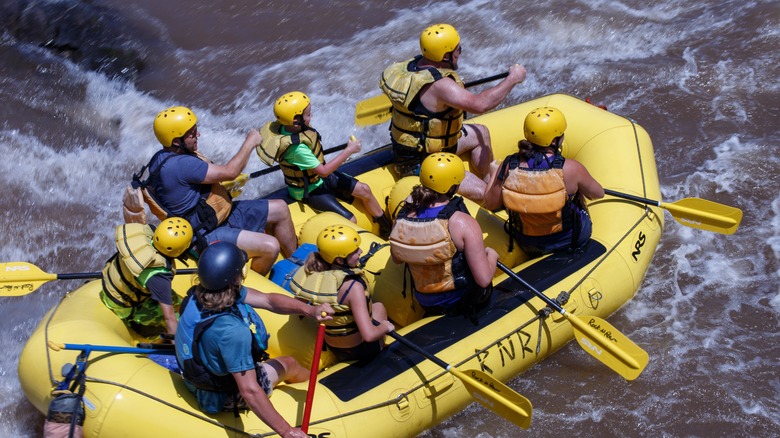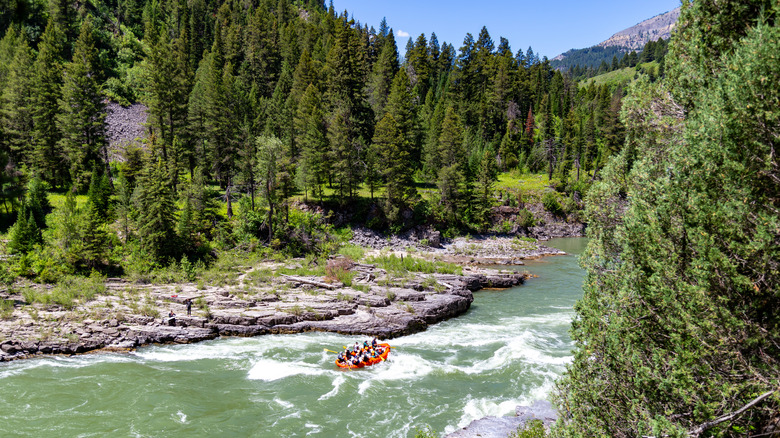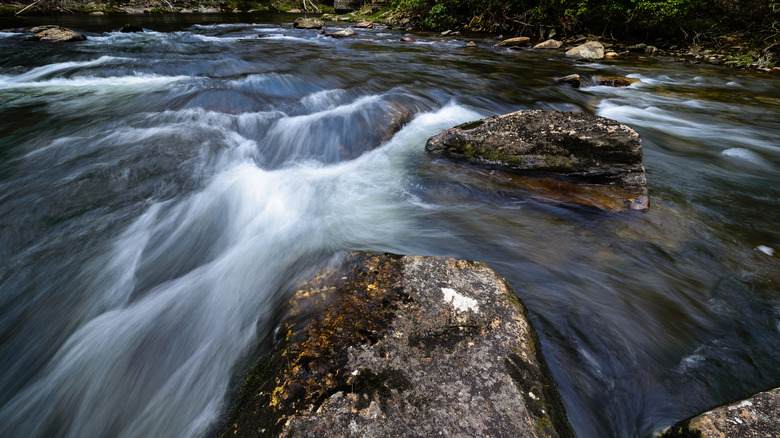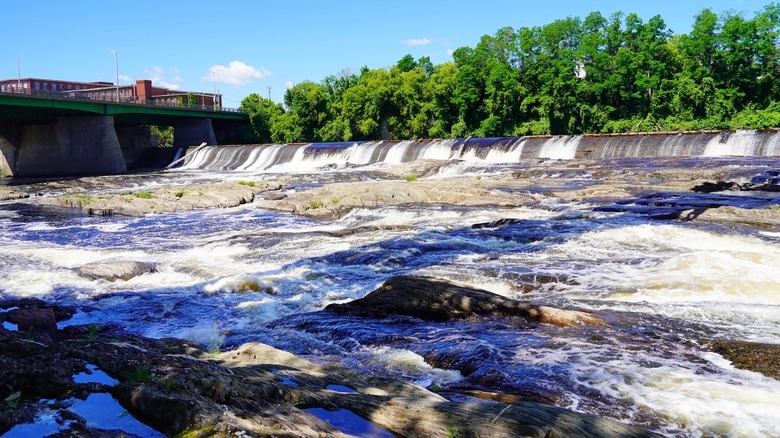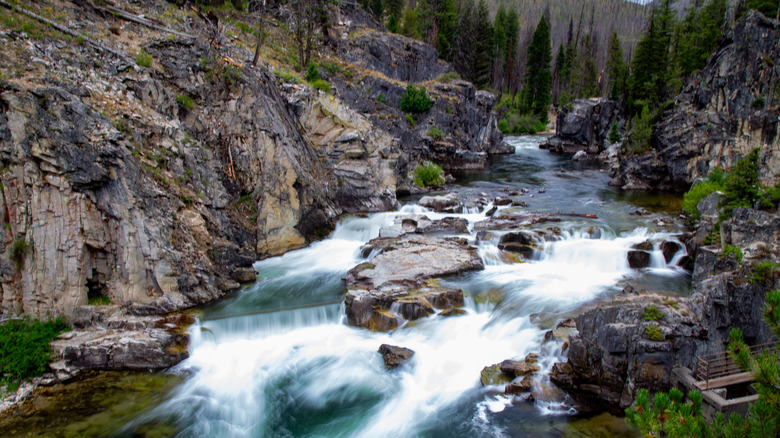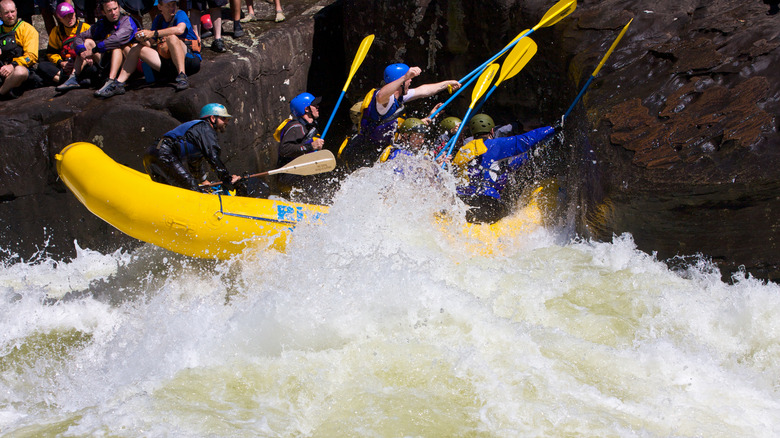The Best Rivers To Go Whitewater Rafting (Other Than Colorado)
The rush of the rapids meets the rush of adrenaline when whitewater rafting, an activity that can provide excitement for thrill-seeking travelers for a single afternoon or a multiday journey. Whitewater rapids require a confluence of factors, typically found in mountainous or rocky regions, where gravity is on the side of the river as it works to carve a path to a larger body of water. The Colorado River is the United States' most iconic when it comes to rapids, beginning in Rocky Mountain National Park and passing through the Grand Canyon, with opportunities to catch a ride in multiple states. But the Colorado is far from the only American river that beckons potential river riders, and you might not have to travel as far as you think to find one of the best rivers for whitewater rafting, which are located across the country.
Rapids are generally rated according to their degree of turbulence, with class I or II rapids being gentle and appropriate for beginners and class VI being, frankly, out of the question for most. You can try your paddles first at the world's largest man-made whitewater river, but if you're a beginner or an experienced rafter looking for the real thing, there are a number of excellent rivers for whitewater rafting in just about every corner of the U.S. Among rankings by experts and river guides, these are the rivers – other than the Colorado — that appear most often in their lists of the best rivers for whitewater rafting.
Snake River
On a map, the aptly named Snake River looks like a cobra poised to strike, but it isn't a total monster when it comes to its rapids. Beginning in Wyoming and snaking its way through Idaho before becoming the border between Idaho and Oregon, it eventually crosses into Washington and meets the Columbia River. Along the way, and depending on the season, its rapids may be rated between classes II and IV, providing opportunities for whitewater adventurers of many abilities.
Whitewater rafting on the Snake River is available in multiple states. In Jackson, Wyoming, a year-round, adventure-filled tourist haven, whitewater rafting journeys take you through the area's famous rapids, including Big Kahuna and Lunch Counter. In Hells Canyon, near the border between Idaho and Oregon, you can get a river's-eye view of a gorge that's even deeper than the Grand Canyon. Many options for rafting in Hells Canyon are multiday experiences, including camping.
Chattooga River
The Southeastern U.S. is perhaps known more for its beaches and barbecue than its mountains, but don't forget that the Appalachian Mountain system, including the Great Smoky Mountains, touches several Southeastern states and produces the river rapids to go with it. The Chattooga River in South Carolina and Georgia churns up class II to V rapids along one of the region's longest undammed rivers, flowing freely according to its natural water level. While the spring snowmelt season can be extremely turbulent for rivers such as the Northwest's Snake River, the Chattooga puts up some of its best currents before the summer sets in.
With river guides operating from various points in South Carolina or Georgia, you can raft on the Chattooga for half-day, daylong, or overnight adventures. Different itineraries cover different sections of the river with varying degrees of difficulty for beginners or those who are already whitewater initiated. Chattooga's rapids have some colorful nicknames to check off your whitewater list, including Jawbone, Sock'em Dog, and Bull Sluice.
Kennebec River
If you like your whitewater rafting surrounded by pine forests, consider one of the Northeastern United States' most popular rafting gems. In Maine, the Kennebec River's class III and IV rapids are governed by scheduled dam releases, creating waves throughout the season that are described by guides as "playful," "bouncy," and "splashy" for a fun, but not highly technical ride for beginners and experienced rafters alike. Scheduled turbine tests at the Harris Station Dam take place four times during the whitewater season, with twice the water volume, perfect for whitewater adrenaline-seekers.
The Kennebec River is entirely situated within the Pine Tree State, with its headwaters fed by Moosehead Lake until it meets the Gulf of Maine along the state's southern coast. Most Kennebec whitewater itineraries originate in The Forks, an underrated adventure destination with seasonal charm, considered Maine's whitewater capital. The 12-mile rafting trip is an all-day adventure, with the bouncy rapids of the upper part of the river — including Big Mama, The Alleyway, and Magic Falls — giving way to a gentler float after lunch.
Salmon River
Idaho's Salmon River, known as the River of No Return, offers intrepid rafters a sense of adventure with its class III and IV rapids, along with a sense of history. Located within one of the largest wilderness areas in the contiguous U.S., relics from Native American tribes, as well as long-gone geological epochs, are visible along the river's 100 miles of spectacular canyon rafting among the granite and forest. Besides its rapids, the sense of isolated wilderness that the Salmon River offers, along with a possible glimpse of several endangered species, makes it a bucket-list experience for rafting enthusiasts.
Because of its length and isolation, rafting the Salmon River is usually a multiday itinerary throughout the summer rafting season, including camping and other river and wilderness activities. Common itineraries include the Lower Salmon River, where one can experience a rapid known as "Bodacious Bounce," the Main Salmon, or the protected Middle Fork. Depending on which portion of the river your journey covers, launches are often coordinated from the Idaho towns of Salmon or Stanley. Transportation options to and from your river excursion may also be coordinated by various Salmon River tour operators according to your budget.
Gauley River
Like Maine's Kennebec River, West Virginia's Gauley River is also subject to dam releases that make for an especially wild ride in September and October, giving it the nickname "Beast of the East" and another important U.S. river that whitewater enthusiasts are keen to put their oars to. The turbulent Gauley, whose rapids are rated IV to V+, is accessible within a day's drive for a majority of the country's residents. Its challenging nature, however, makes it primarily a ride for river warriors 15 and up.
Divided into Upper and Lower sections, daylong trips on the Gauley are led by various tour operators located mainly near Fayetteville in central West Virginia. The Lower Gauley is a wild ride without the white-knuckling, with falls, waves, and whirlpools that include everything between "Fuzzy Box of Kittens" and "Pure Screaming Hell." Ten seconds can be a long time when your pulse is racing, and the Pillow Rock rapids, pictured above, among the Upper Gauley's churns and whirls, is considered the "best 10 seconds in whitewater."
